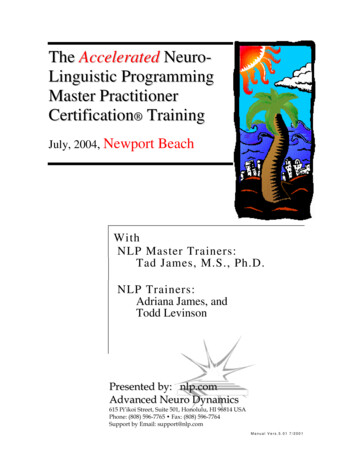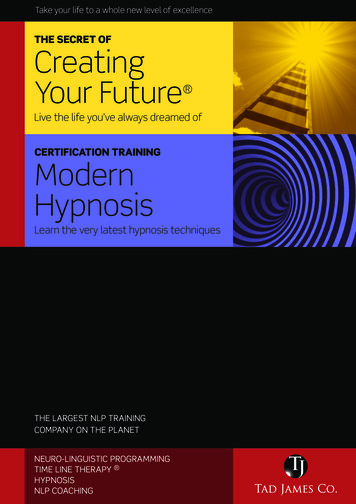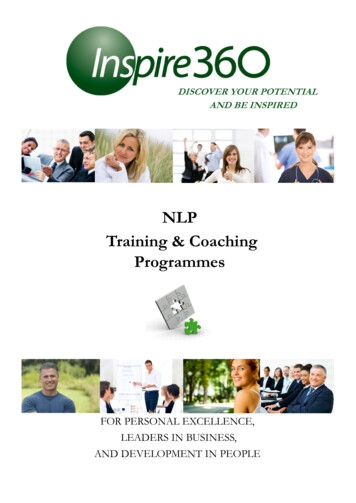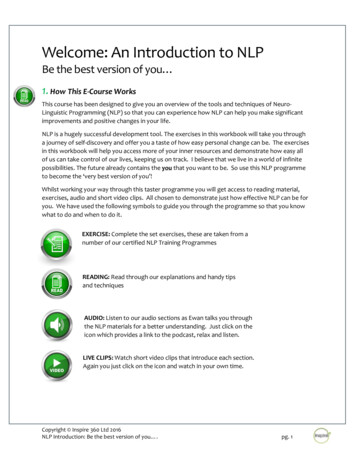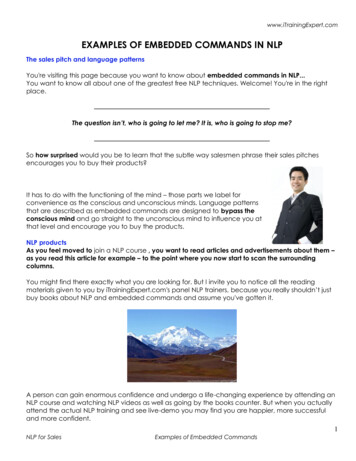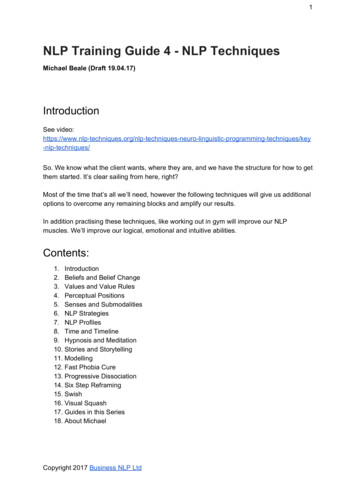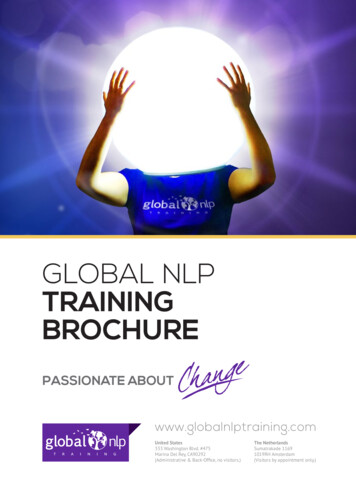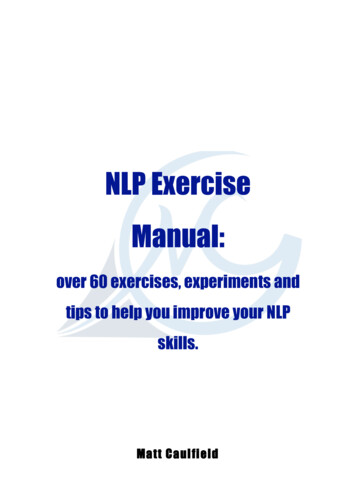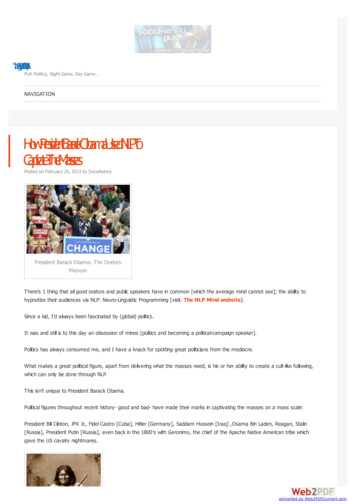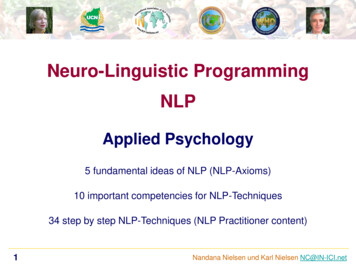
Transcription
Neuro-Linguistic ProgrammingNLPApplied Psychology5 fundamental ideas of NLP (NLP-Axioms)10 important competencies for NLP-Techniques34 step by step NLP-Techniques (NLP Practitioner content)1Nandana Nielsen und Karl Nielsen NC@IN-ICI.net
Card 1: IntroductionIn NLP, many excellent interventions (techniques) have been developed as step-by-step instructions. Wehave put together the most important and most effective NLP basic ideas (axioms), NLP skills and NLPinterventions (techniques) of the "NLP Practitioner" in this card set.To successfully apply NLP you need: an understanding of the basic ideas of NLP (5 NLP axioms) - see cards 5-6 10 basic skills that are required for all NLP interventions - see cards 7-16. 34 very specific step-by-step NLP interventions (techniques) - see cards 17-50Prof. /UCN Nandana Nielsen and Prof. /UCN Karl Nielsen are the authors of the present set of cards. Theyhave been trained by the NLP developers, have applied their knowledge since 1985, are the owners of theNLP & Coaching Institute Berlin, Presidents of the “International Association of NLP-Institutes" and the"International Association of Coaching Institutes" and as professors have been charged to develop thecorrespondence course in psychology with a focus on NLP and Coaching (Dr. / PhD) by the UniversidadCentral de Nicaragua ool-of-psychology/Practice makes perfect, so we ask you to practice these subjects diligently. These cards do not replace anNLP training – they are designed to arouse curiosity and allow you to take your first steps in NLP. This cardset is a base and an excellent reminder of the important contents in NLP trainings.2Nandana Nielsen und Karl Nielsen NC@IN-ICI.net
Card 2: What is NLPNLP stands for Neuro Linguistic Programming. It is a collection of methods for professionalcommunication, both for meaning oriented intrapersonal communication, and for receiveroriented interpersonal communication.The inventors of NLP are: Dr. Richard Bandler, Dr. John Grinder, Leslie Cameron-Bandler, JudithDeLozier, Robert Dilts.The first phase of the development of NLP started from 1972 to 1978 at the University of Californiain Santa Cruz. The NLP inventors modeled: Dr. Fritz Perls (psychoanalyst, founder of GestaltTherapy), Dr. Virginia Satir (founder of family therapy) and Prof. Dr. Milton Erickson (hypnotherapy),based on the scientific work of William James (cognitive psychology), Alfred Corzybski (generalsemantics), Gregory Bateson (system theory), Albert Bandura (learning theory) and NoamChomsky (linguistics).After 1978, NLP users modeled successful communicators from all walks of life: business,psychotherapy, sports, knowledge, education, employee communications, team development,coaching, .From the results, they have developed NLP methods and step-by-step instructions designed to helppeople to imitate the skills of highly successful people and discover their own particularity.3Nandana Nielsen und Karl Nielsen NC@IN-ICI.net
Card 3: List of NLP axioms and NLP skills4NLP axiomsC-5C6NLP axioms: 5 NLP basic attitudesNLP axioms and NLP contents as wisdomNLP skillsC7C8C9C 10C 11C 12C 13C 14C 15C 16Perception and interpretationRapport with Backtrack and Pacing & LeadingVerbalizing emotional experiencesDealing with incongruencies"As if" techniqueVACOG tranceVAC languageEye movement informationSCORE – Moving from Symptom to OutcomeEcology Check with Future PaceNandana Nielsen und Karl Nielsen NC@IN-ICI.net
Card 4-1: List of NLP techniques (interventions)C 171st, 2nd, 3rd Position with others and with a symptomC 18SMART goalsC 19ChunkingC 20Logical LevelsC 21New Behavior GeneratorC 22Was that the intention of your communication?C 23Intelligent handling of criticismC 24Field of personal excellence and Magic FieldC 25Success with TIAUP anchorC 26Anchor mergeC 27Visual SquashC 28Change HistoryC 29Context ReframingC 30Six-Step ReframingC 31Submodalities TransferC 32Praline FormatC 33Swish5Nandana Nielsen und Karl Nielsen NC@IN-ICI.net
Card 4-2: List of NLP techniques (interventions)C 34Fast Phobia CureC 35Meta Model 1 - GeneralizationsC 36Meta Model 2 – Cause and Effect DistortionC 37Meta Model 3 - Modal DistortionC 38Meta Model 4 - Lost Performative-DeletionC 39Meta Model 5 - NominalizationsC 40Milton Model 1 - Inverted Meta-ModelC 41Milton Model 2 - Go First and Vague LanguageC 42Milton Model 3 - Embedded Quotes and PromptsC 43Exploring and Changing the TimeLineC-44Ground TimeLine for good experiencesC 45Get treasures from the past for a goalC 46Disney StrategyC 47Eye Movement IntegrationC 48Model the best moments in lifeC 49Metaphor interventionsC 50Metaphor stories6Nandana Nielsen und Karl Nielsen NC@IN-ICI.net
Card 5: What is NLPThe basic NLP attitudes are summarized in NLP axioms. These axioms are no truths but successorientations. They are the foundations of NLP interventions (NLP Techniques).Here are the 5 most important axioms:1. The map is not the territory: People respond to their ideas of reality, and NLP can changethese ideas - thus reactions can be changed.2. Behind every symptom and every behavior lies a positive intention: Every issue contains atleast one gift (potential for further development) – this axiom changes the mental searchdirection, people’s moods, and increases the probability of success.3. The intention of your communication is the reaction you get: Change your communication aslong as you need to in order to get the desired reactions - this axiom changes the focus fromthe passive problem consciousness to an activity oriented state of mind.4. Everything depends on everything else: If you change your thinking you change youremotional state, your perception, your language, your behavior and your interpersonalrelationships - this axiom opens the door to change.5. NLP is systemic, solution-oriented, resource-oriented and ecological- NLP integrates theeffects of NLP interventions in an ethically responsible the territory: People respond to theirideas of reality, and NLP can change these ideas - thus reactions can be changed.7Nandana Nielsen und Karl Nielsen NC@IN-ICI.net
Card 6: NLP axioms and NLP contents as wisdomIn classical NLP training modules, you will find wisdom specifically applicable in NLPinterventions (see C17-50).Self Management: First, always get in a good condition, then many things are much easier to handle, and sometake care of themselves. If you do what you've always done, then you will achieve what you've always achieved.Body Language: If you want to understand another person, then try to take their position. Before you judgeanother human being, first run a mile in their moccasins. Your unconscious permanently comments everything youdo by sending emotions.Goals & Motivation: The journey is the goal.Anchoring / Emotion Triggers: If you wish to contribute to peace, then first of all try to find peace inside yourself.It's never too late to have had a happy childhood.Reframing / Reinterpretation: Our lives are shaped not by the events that we go through, but by the meaning wegive to these events.Submodalities (see C31): The type of your mental storage determines your behavior.Meta & Milton Model: The way people form their sentences reveals the way they influence their own perception.TimeLine: Time is a matter of choice.Strategies: Only the union of your inner mental forces leads to extraordinary results.Metaphors: Metaphors convey wings to the soul.8Nandana Nielsen und Karl Nielsen NC@IN-ICI.net
Card 7: Perception and InterpretationWe perceive reality with our five senses. Every statement should always beexamined according to the question whether it contains concrete verifiableperceptions or interpretations difficult to verify.Step sequence in small groups:1. A tells B: "I perceive in you that. (you are pulling the corner of your mouth, theskin color turns pale, your voice gets louder .)". The others make sure thateverything that is said is about perceptions.2. "From this I interpret that you. (take pleasure, are insecure, afraid, .)". Theothers make sure that everything is interpretation.3. B tells A: "And as you said, I've noticed in you that ." The others make surethat it is really about perceptions.4. "From this I interpret that ." The others make sure that it is interpretation.This step sequence is endless and trains the perception of the difference thatmakes a big difference.9Nandana Nielsen und Karl Nielsen NC@IN-ICI.net
Card 8: Rapport, Backtrack, Pacing, LeadingWe adjust our body language to that of other people (rapport). This allows us to understandthem better, they feel understood and we can assist them in changing their emotional stateand becoming solution- and resource-oriented. This sequence comprises seven steps:1. Summarize briefly the content of what the other has said (Backtrack) before you respond tothat content.2. Adjust your speaking rate, your voice volume and voice pitch to that of your interlocutor, thusbuilding rapport with the other person’s pronunciation.3. Imitate the posture of your interlocutor (overall body posture, arm and leg position). Mirror-likerapport is strongest most but also very conspicuous.4. Emulate the gestures and facial expressions of your interlocutor by replicating them withBacktrack.5. Use the same kind of words as your interlocutor (see C13).6. Adjust slightly to the breathing rhythm of your interlocutor.7. Find out if small changes in the way you speak (2) or move (3, 4, 6) are unconsciouslyimitated by your interlocutor. If you notice Rapport, you have paced sufficiently (adjusted yourbody language), then you can lead your interlocutor into a better condition. If you change yourstate he will imitate you automatically.10Nandana Nielsen und Karl Nielsen NC@IN-ICI.net
Card 9: Verbalizing emotional experiencesWe can amplify the Backtrack (see C8) by paying particular attention to the emotional levelof our interlocutor. The fact that we consciously address this level of communication makesit is easier for our interlocutor to open up to this level.Sequence of steps1. Summarize what the other person has just said and just go along, with particularreference to what resonates emotionally. It is helpful to formulate the contents in a verygentle way.2. Build a good Rapport with your interlocutor by emulating their body language, theirposture, gesture, language and breathing rhythm (see C8).3. If the body language Rapport is strong enough, you can lead your interlocutor intosolution and resource-oriented states. If you change your state they will automaticallyfollow you (see C8) if your Rapport is strong enough.11Nandana Nielsen und Karl Nielsen NC@IN-ICI.net
Card 10: Dealing with incongruenciesYour interlocutor’s unconscious is your best friend. It permanently communicates with youvia the body language. Incongruencies are your interlocutor’s unconscious body languageclues indicating that something may be different than expressed verbally. Incongruenciesreveal your interlocutor’s unconscious opinion about what he says. Therefore it is worthwhileto maintain this relationship with the help of NLP. You can use one of the options below andask the As-if Question: "If there was still something that should be taken into account, whatcould it possibly be?":Useful interventions before asking the As-if Question1. Imitate incongruence by using body language backtrack (see K8).2. Reflect incongruity by using verbal backtrack, for example by asking: "Isn’t it?3. Reflect incongruity by using non-verbal backtrack, for example, generate any incongruity(face warp)4. Ask directly about the incongruence: "What does your (call body signal) feel about your.?" This is only possible with very close friends or in coaching / therapy.12Nandana Nielsen und Karl Nielsen NC@IN-ICI.net
Card 11: As-if QuestionsIn some conversations, if your interlocutor says that he does not know or cannot imaginesomething, we encourage you to try As-if Questions. Sometimes it works wonders andsometimes it does not fit.Variations of the As-if QuestionAs-if of the way: If you want to ask for inner experience during an NLP intervention and you want toknow whether something is bright or dark, loud or soft, warm or cool . and your client and says: "Ido not know." it is worth asking, "What comes to your mind first?"As-if of the solution: "If you had an idea for a possible solution to this issue, which could be thebest?"As-if of the time: "If you look back from a moment in 10 years, what could you possibly see fromthat perspective that could be a solution?"As-if of the miracle: "Suppose a miracle would happen, what would probably be different?"As-if of the person: "What could someone else think about it?"As-if of a symbol: "What could a ball / tree / the sun / think about it? "13Nandana Nielsen und Karl Nielsen NC@IN-ICI.net
Card 12: VAKOG TranceIn many NLP interventions all senses are activated: sight (V: visual), hearing (A: auditory),feeling (K: Kinesthetic), smell (O: olfactory) and taste (G: gustatory). Often only the first 3senses are used, and O and G are considered as parts of K. The properties of thesesensory areas are called submodalities in NLP. By activating all the senses things areexperienced intensely, memories are recalled better, ideas are mentally anchoredstronger, and learning is facilitated.Examples of VAKOG submodalitiesV: color, brightness, size, location, shape, intensity, A: sound/melody, volume, theme, word, sentence, K: sensation, respiration, temperature, motion/rest, weight, gesture, O: fresh, fruity, flowery, like a particular perfume, .G: spicy, mild, sweet, tasty, .14Nandana Nielsen und Karl Nielsen NC@IN-ICI.net
Card 13: VAK languageIn NLP, we pay special attention to the sensory channels that our interlocutor uses when expressinghimself. When speaking, we try to use the same sensory channel as our interlocutor, and thusenhance mutual understanding. Rarer variations in smelling (O) and taste (G) are expressions like:"That doesn’t go down well with me." or "He smells a rat."Examples of VAK expressionsV: look at, evocative look, sparkle, view, horizon, obviously, . "Overview brings clarity andinsight. Look how many clues you can find if you keep your eyes open."A: answer, discuss, ask, listen, sound, calm, translate, shrill, silent, say, agree, mood, harmony,. "It's not what you say, but how you say it.“ “to be in accord with something”. “If that came tohis ears "K: work, treat, press, firm, fit, run, soft, wear, position, in control, grab, . "That’s a piece ofcake, in the twinkling of an eye, you assemble some more notions, and you feel comfortable."V is often accompanied by rather fast talking, high speech tone, upright posture, and fast gestures, Aby melodic speaking, and K by a rather deep speech tone and slow abdominal breathing andspeaking.15Nandana Nielsen und Karl Nielsen NC@IN-ICI.net
Card 14: Eye movement evidenceEye movements provide clues to the sensory channel people use. You can adjust to them by usingwords from the same sensory channel. This will also train your attention and your perception.Vre Visually remembered (internal images)Vc Visually constructed (internal images)Are auditory remembered (listen)Ac Auditory constructed (listen)AID Auditory Internal Dialogue (conversation)K Kinesthetic (emotions)Posture, breathing, gestures and VAK language (see C13) provide additional hints to thesensory channel people use.16Nandana Nielsen und Karl Nielsen NC@IN-ICI.net
Card 15: S.C.O.R.E.SCORE is a proven sequence of questions designed to find out about your interlocutor’s mental mapwhen problems arise, and to professionally move from the problem towards the desired goal. Even ifit is obvious that the other person ascribes their problem to the wrong reasons, we must be awareof the fact that it is anchored in their thinking, and thus we learn at which point we can meet them.So in order to make sure you understand your client correctly, we recommend that you backtrack atevery step and look out for matching agreement.Step sequence1. Symptom: find out about the problem: "What exactly is it about?"2. Cause: find out about the cause: "Where did the problem originate?"3. Outcome: "What would you like to achieve in this situation?" (see SMARTe C18)4. Resources (for example, skills, time, money .):a) already existing resourcesb) required resources5. Effect: "Which implications arise when you have achieved your goal?" (see Ecology C16)SCORE is suitable for preparing an NLP intervention. It can also be used as a continuous improvement process for employee survey. SCORE is sometimes all it needs to produce the desired change.17Nandana Nielsen und Karl Nielsen NC@IN-ICI.net
Card 16: Future Pace and Ecology CheckNLP is systemic, and in all NLP interventions we need to integrate the relationships andimpacts (Ecological check) by asking the client at the end of each NLP intervention toimagine the future (Future Pace). We pay special attention to incongruencies, which arepositively reframed (reinterpreted) and used as unconscious objections (see K10): "Ifthere was something left to consider, what might that be?Future Pace: Imagine the impact of a change in the future.Ecological check: Ask the client how specific developments fit to his person, to his life,and his environment. Ask for possible implications and consequences and pay attentionto incongruencies.18Nandana Nielsen und Karl Nielsen NC@IN-ICI.net
Card 17: 1.2.3. PositionThis NLP intervention is a further development of the "hot chair" of Gestalt therapy. The intervention startswith a conflict a person has with someone (B) or symptom a person suffers from (B). If you only try tofigure out the situation in your thoughts, you will only get about 3% of the possible information.Sequence of steps191.Take the first position: How do I feel there? What do I think about the other person (or the symptom)?2.Imagine the other person (or the symptom) on a second chair, using the "VAKOG" technique (see C12).The more intensity you can achieve, the better it is for this intervention.3.Talk directly to the other person. Tell them what you think of them. Watch for their reaction.4.Now switch places. Take the second position. How does it feel there? Explore this position.5.Look at the person in the first position. Talk to him or her.6.Now you can switch several times between the two chairs and give an answer from every position.7.Go to a third position from which you can see the two other positions. Which aspects have escapedyou in the first and the second position?8.Integrate the findings into the other positions by moving back in there.9.Make a final check on Future Pace ecology (see C16).Nandana Nielsen und Karl Nielsen NC@IN-ICI.net
Card 18: SMART goalsThe journey is the destination. Scientific research confirms that those who mentally enhance theirmotivation on the way to the goal are much more successful than those who only intensify theirvisualization of the goal. Therefore, we focus on the goal-oriented forces that can accompany us on theroad.Sequence of stepsSpecific situation: Write down your first goal. The words you use shoud not contain anynegation or comparison. Then look at the visualization of the target situation. Which are thefaculties you need to develop in order to get to the destination? The goal we want to achievehere is the deployment of these faculties.Measurable: How can the development of the required faculties be measured objectively?Attractive: Intensify the attraction of these forces by using the VAKOG questions (see C12).Realistic: Make sure that the final goal and the goal of each step can be reached by your ownendeavour.Timed: When exactly does the final goal and the goal of each step need to be achieved?Ecology: Mind the system ecology: What are the possible impacts of the goal when you havereached it? Pay special attention to incongruencies (see C10).20Nandana Nielsen und Karl Nielsen NC@IN-ICI.net
Card 19: Chunking - up, down and sidewaysTo chunk up means to ask for the higher level of something. Monetary targets for example often stand forthe things somebody would like to buy, and in turn, by possessing certain things, people often hope toachieve a sense of well-being.Chunk sideways enhances motivation by activating the right hemisphere.Chunk down creates precision on the basis of chunk up and chunk sideways.Sequence of steps1. Apply the two chunk-up questions to a target: "What would you achieve if.?" and "What do youwant to achieve?" If possible, repeat these questions several times.2. Intensify the higher goal by chunking sideways: "To achieve this goal is for you like . (what)?" Herewe are looking for motivational metaphors and referencial experience.3. When chunking down, you ask: "When, with whom, by which means and how exactly do you wantto do this? What exactly do you need to do in order to get there? And what else? And what else?"Chunk sideways can also be used in smalltalk situations in order to change the subject of the conversationby referring to something the other person has said and responding with: "This reminds me of ."Chunk up can also be used in stalled negotiations and for finding the ethically acceptable goal behindunethical aims.21Nandana Nielsen und Karl Nielsen NC@IN-ICI.net
Card 20: Logical LevelsThe pulling force of the goals can be greatly enhanced by the Logical Levels. By adding the universe and a symbol,even more creative levels are activated.In the original form developed by Robert Dilts, the level called “vision” comprises the “universe” and the “symbol”.Sequence of steps221.In what kind of environment do you imagine to realize your goal?2.What kind of behaviour do you show?3.Which skills do you use?4.Which beliefs and values does your goal incorporate?5.How do you define your identity in the process?6.Now look up and left. Imagine the universe there (allow time for it). Now move two steps forward, turn leftand step into the universe. Become the universe. Explore the situation from the position of the universe. Giveyourself a recommendation. Send this recommendation to the identity level. Go back to the identity level andreceive the recommendation.7.Now look to the right. Let there arise a symbol. Move two steps to the right, to the front . Keep it up the wayyou did at the universe level: take the position of the symbol, enquire its message, send a recommendationand receive it at the identity level.8.With this new energy now move back all the steps to beliefs and values, skills, behavior and environment, andsee how this energy affects each level.Nandana Nielsen und Karl Nielsen NC@IN-ICI.net
Card 21: New Behavior GeneratorBasically, the New Behavior Generator is a New State Generator - it creates a new state that allows anew behavior. In this NLP intervention, many NLP skills are included.Sequence of steps1. Take a SMARTe goal and define each step to the goal (see C18).2. Imagine yourself a few feet away, as you develop your skills that will lead you to yourdestination. In what kind of environment do you see yourself? What kind of situations triggerthe development of these faculties? Which values and beliefs come true here?3. Intensify this idea by using VAKOG (see C12). This kind of dissociated imagination helps toactivate your motivation.4. Then you go to the place where you saw yourself and stay there. Experience and enjoy it. Thisassociated imagination increases your belief in your ability.5. Does everything feel completely right? Are there any incongruencies (see C10)? If there issomething left that needs to be changed, then go back to 1., change the formulation of your goalaccordingly and repeat the whole sequence.23Nandana Nielsen und Karl Nielsen NC@IN-ICI.net
Card 22: Was this the intention of your communication?This is an advisory or coaching intervention used for situations in which your interlocutorcomplains about someone behaving inappropriately towards them. Thanks to NLP youare immediately able to modify your behavior if the person responds differently fromwhat you expected: Change your behavior until the reactions go in the desired direction.Sequence of steps1. Steer the conversation to the point where your interlocutor says that the personabout which he complains, reacts inappropriately.2. Then you ask: "Which reaction would you like to get?"3. Use Backtrack (see C8), and then ask: "How do you need to behave in order to get thedesired reaction?"4. Now you can imagine yourself using the new behavior, and practice it with role-play.(In order to facilitate the use of the new behavior, you can additionally use NBA (seeC21) and 1.2.3. position (see C17).24Nandana Nielsen und Karl Nielsen NC@IN-ICI.net
Card 23: Dealing with unfair criticismBetween stimulus and response lies a gap. You can enlarge this gap using NLP.The following NLP intervention can be applied if someone criticizes you unfairly. If you are rightlycriticized, you just apologize and try to correct your behavior with your interlocutor’s help.Sequence of steps1. Save time Part 1: Only say two words, e.g. "Oh yes.", or "Oh!" or "Well, well." This gives youtime to think. Step a little to the side, so that the attack energy can flow past you.2. Part 2: Use the question form of Backtrack (see K8), e.g. with: "Have I understood you correctlythat you mean,." Perhaps this already clarifies the situation.3. Part 3: You pay tribute to their critics, e.g. with: "Thank you for addressing this so openly anddirectly. You are obviously interested in finding a solution."4. Part 4: Apologize without apologizing by saying something like: "I'm sorry if I.you with " Thatcalms down many attackers, even though you haven’t admitted anything.5. Now you have saved enough time and can pass on to the attack if you want, e.g. by saying: "Iunderstand that you see that this way from your point of view." or, "What exactly would you likeme to do now?"25Nandana Nielsen und Karl Nielsen NC@IN-ICI.net
Card 24: Energy Field of personal excellence and Magic FieldSequence of steps1.Try to remember a situation in your life in which you felt particularly excellent, completely fine, where youwere in the flow, in line with your emotions, your values. Remember emotional details as intensively aspossible.2.If you would see a field of energy 2-3 meters in front of you now that expresses exactly this mood, what colorwould it have? What sound would it have? What kind of energy can you see there? (Submodalities see C31)3.Do this with at least two other past resourceful states and intensify the energy field on and on.4.When the energy field has become really intensive, step into this field and enjoy it. While standing in the field,see how the power intensifies even further.5.Step in and out for a few times. Look at the energy field from outside and experience it from within. It is yourfield of personal excellence.6.Think about future situations in which you can use this energy field.7.Find a name for this field of energy, connect it with a little movement and get used to your energy field in thenext time. Practice repeatedly to let it arise, and step into it. Then this tool will be available to you even inchallenging situations.Magic Field: You can use a variation where your unconscious shows you the magic energy field that it considersbest for you. Instead of 1 you ask your unconscious to let emerge in 2-3 meters before you a field of energy thatwould be very good for you and your further development to experience. Skip 2. Everything else is the same.26Nandana Nielsen und Karl Nielsen NC@IN-ICI.net
Card 25: Success anchorThe success anchor is a pile anchor that connects positive experiences from the past with a selectedlocation on the body. If you build this anchor well, it will serve you in critical situations.Sequence of steps1.2.3.4.5.6.27Pick a spot on the body that you want to use as "anchorage".Now remember a powerful experience in all sensory channels (see VAKOG C12).Once the memories unfold and you can feel them intensely, touch the selected spot on your body.Do this with several powerful memories.In critical situations you make the same movement to restore this state of power.In order to remember what really matters when anchoring you can use the acronym TIAUP.Timing: If you anchor just before the unfolding of your memory has reached its climax, you can use thedynamics of the inherent movement as well.Intensity: Using all VAKOG channels increases the effectiveness.Accuracy: The memory and the emotion stored in an anchor can be best recalled when the anchor isstimulated in exactly the same way as it was set (same location, movement, pressure, .).Uniqueness: The spot on your body at which you want to anchor an emotion should not be alreadyoccupied by strong memories.Purity: Whatever you think about when anchoring will be anchored along with the intentional anchor.Nandana Nielsen und Karl Nielsen NC@IN-ICI.net
Card 26: Anchor mergeAn anchor merge is an NLP intervention designed to set and test two emotional states asanchors, and then to activate them simultaneously or in quick succession. NLP is changeof one’s state of mind. In certain states of mind, we only have limited behavioral optionsat our disposal. Anchor merging enables us to extend our behavioral options.Sequence of steps1. Activate a negative anchor with VAK, anchor it on a spot on your body, and test it.Here, a separator is not required since this sequence will not be changed afterwards.2. Activate a positive anchor with VAK, anchor it on a spot on your body, and test it. (youmay use staple anchors, see C25).3. Separator: use an interruption or a distraction.4. Enable both anchors simultaneously or in succession (first enable the negative, thenthe positive anchor), and mix both anchors. Trance language is helpful here (see C4042).28Nandana Nielsen und Karl Ni
Prof. /UCN Nandana Nielsen and Prof. /UCN Karl Nielsen are the authors of the present set of cards. They have been trained by the NLP developers, have applied their knowledge since 1985, are the owners of the NLP & Coaching Institute Berlin, Presidents of the “International Association of NLP-Institutes" and the
